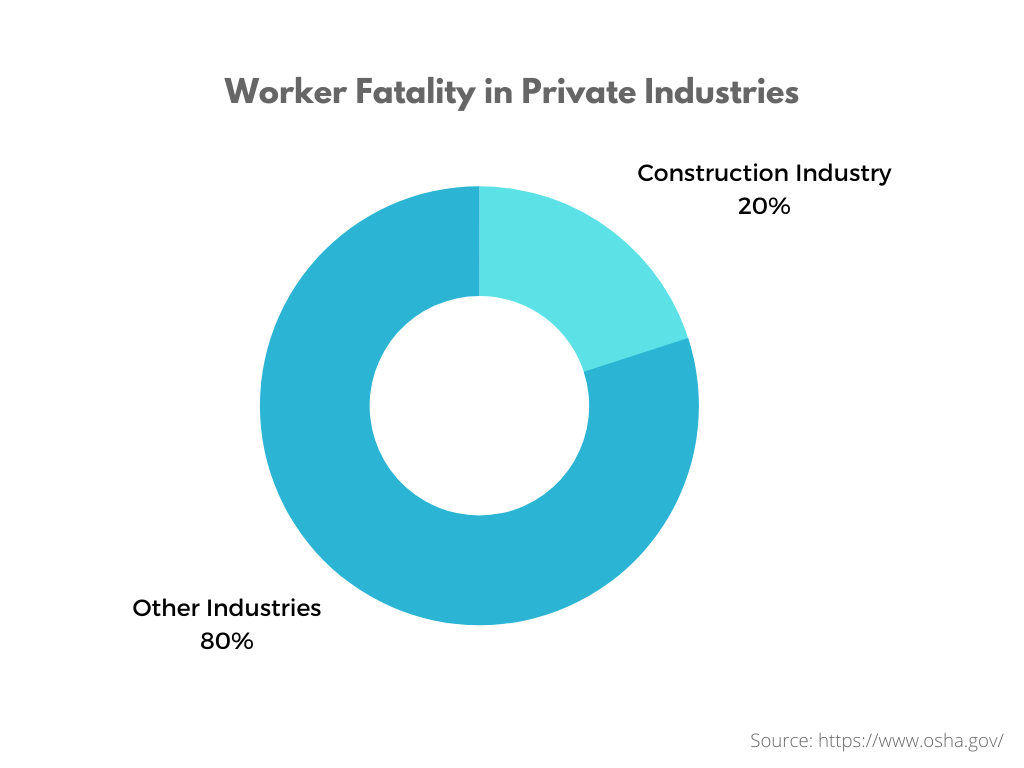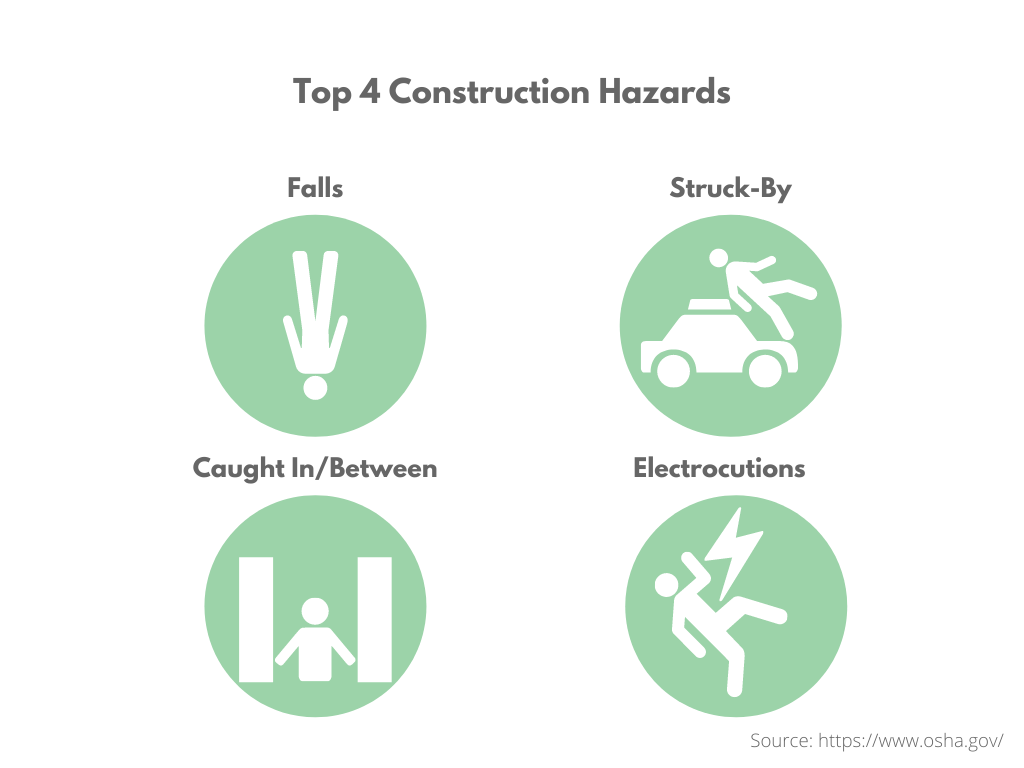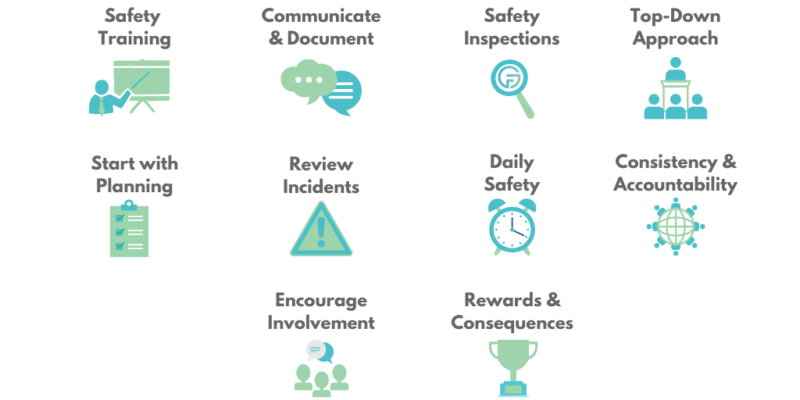Undoubtedly, safety is imperative in the construction industry. According to OSHA, the construction industry accounted for almost 20% of worker fatalities in 2019 for the private industries sector. For this reason, construction companies strive to create and promote a culture of safety. The goal is to ensure the well-being of their employees. Safety is more than just providing PPE and training. It is about sending a message.
Safety culture is the collection of shared behaviors, beliefs, and values about safety and wellbeing. It is the collective dedication to preventing injuries and fatalities within the work environment. A safety culture encourages employees to be proactive. As a result, employees become well-equipped to identify risks and make good choices. Instilling a culture of safety allows companies to minimize safety hazards, mitigate risks, and reduce the number of safety incidents. There are many steps a company can take to implement a culture of safety.

Implement Safety Training
Safety training can start as early as the new employee onboarding process. A safety curriculum will help employees build a foundation of safety knowledge. They will learn how to identify and react to safety issues to create a safe workplace. OSHA recommends that all employees receive proper training to learn how to follow OSHA standards and requirements. Construction companies can discover safety-related information and training on OSHA’s website. All employees should receive training about the Fatal Four. The four hazards that account for the most injuries and fatalities are falls, struck-by, caught-in/between, and electrocutions.

Communicate & Document
OSHA recommends that all construction companies post safety documentation throughout the workplace and at all job sites. These documents serve as a reminder for employees to prioritize safety and remain in compliance. Additionally, organizations can have safety training documentation and internal safety policies and procedures readily accessible to all employees. Employees can review documentation as needed. Communication is also critical. Leaders should communicate to employees about safety issues so that everyone is on the same page.
Conduct Regular Safety Inspections
Prevention is always better than a cure. Conducting regular safety inspections helps companies determine what areas are falling short of the standards. As a result, organizations can pinpoint and address issues as soon as they are known. Uncovering potential problems at the start will help all job sites comply with current laws and regulations. In turn, this will reduce safety incidents.
Top-Down Approach
There are two ways to shape company culture; top-down and bottom-up. However, when it comes to safety culture, the best approach is top-down. Managers must conduct themselves in a manner that exemplifies a culture of safety. People tend to mimic what they see and learn. For this reason, upper management needs to be effective role models by modeling behavior they wish to see from their employees. Leading by example means that managers should be involved in toolbox talks, training, and other discussions about safety. Building a safety culture starts from the top down and is maintained at every level.
Start with Planning
Creating a culture of safety should not start only after an incident has occurred. Instead, safety should be a priority from the start. As early as the planning stages of a job, a safety culture can be at the forefront of a company’s mind. Organizations can start by analyzing what safety issues may arise and implement a plan right away. Additionally, it may be helpful to use tools like checklists or software. It is essential to keep track of enacted safety measures as well as future safety measures.
Review Incidents
When any safety incident occurs, whether big or small, it is vital to review the situation. Investigating all incidents or near misses will provide crucial data about what areas of safety need additional consideration. Additionally, it will reveal what is working well. Gathering fundamental data offers companies a better understanding of how to improve their safety culture. This understanding will help companies identify safety challenges and make the necessary modifications to achieve a safety culture.
Make Safety Part of the Routine
Instead of only talking about safety during safety training or safety-designated events, why not make safety a part of every day? By consistently incorporating safety topics into daily activities, it makes it a priority. Discuss safety during other opportunities such as weekly meetings and at the start of work shifts. Having frequent toolbox talks with the crew will reinforce the significance of being safe. Give employees the chance to ask questions and ensure that they have a clear understanding of safety expectations.
Consistency & Accountability
Safety should be a core value of every construction company. To achieve a culture transformation, employees at all levels of an organization must show personal commitment to a safety culture. Likewise, it should not fall on a single person or department to practice safety. Everyone should be accountable regardless of their job position. Consistent reinforcement of safety policies will help all employees comply with safety standards.
Encourage Involvement
Creating a culture of safety requires a team effort. One way to promote teamwork is to create a safety committee. A safety committee can be composed of personnel from all levels and of the organization. Bringing together a variety of people offers perspectives from various groups. Together, a safety committee can be involved in reviewing and updating current safety programs. Team involvement creates a sense of responsibility for each individual. Another form of involvement is asking workers to provide feedback. When people feel valued, they are more likely to be invested in a culture of safety.
Rewards & Consequences
Once guidelines and expectations are clearly defined, the next step is to implement a system of rewards and consequences. It is essential to communicate this information to all levels of the organization. Encourage safe practices by rewarding employees who go above and beyond to make work a safer place. Additionally, it is critical to enforce safety guidelines by giving consequences to employees who violate the protocols. Penalizing unsafe behavior while rewarding safe behavior will encourage workers to put safety first.

Conclusion
Safety is an integral part of the construction industry. It protects employees and companies as a whole. When a company promotes a culture of safety, it sets everyone up for success. Employees will become well-equipped with the tools and training necessary to create a thriving and safe environment. Additionally, employees will learn to be proactive, take accountability, and become committed to achieving a culture of safety.
Learn more about how our Field Observation Software can assist you in creating a culture of safety.
How has your company promoted a culture of safety? Let us know in the comments below.



